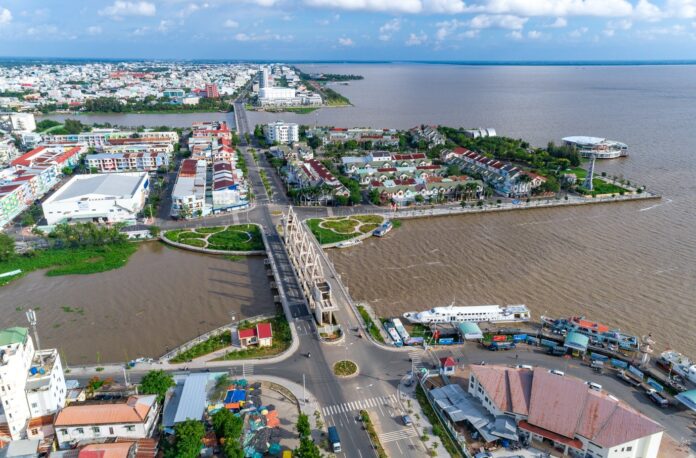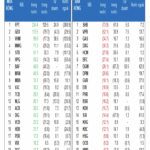Vietnam’s Most Populous Ward: A Dynamic and Vibrant Urban Center
Kien Giang province now has 48 administrative units at the commune level, including 41 communes, 4 wards, and 3 special districts, following the rearrangement of administrative units at the commune level. The most notable change in this adjustment was the establishment of Rach Gia ward by merging nine wards of Rach Gia city: Vinh Quang, Vinh Thanh, Vinh Thanh Van, Vinh Lac, Vinh Hiep, An Hoa, An Binh, Rach Soi, and Vinh Loi.
With a population of 250,661 people after the merger, Rach Gia ward surpasses Di An ward in Ho Chi Minh City (with approximately 227,817 residents) to become the most populous ward in Vietnam. The ward covers an area of 45.53 km², resulting in a population density of over 5,505 people/km², making it a bustling and vibrant urban center with a special role in the development structure of Kien Giang province.

Rach Gia is a unique coastal urban development. Photo: Construction Magazine
Previously, the People’s Committee of Kien Giang province identified Rach Gia urban area as the political, economic, cultural, and social center of the province. Rach Gia is oriented to develop into a national and international tourism and trade service center.
It will serve as a tourism support center for the key national tourism area of Phu Quoc – Ha Tien – Rach Gia, a green and sustainable urban area, a smart city that adapts to climate change… The infrastructure of Rach Gia is being invested in synchronously in conjunction with urban renovation, creating a modern and harmonious new look, promoting comprehensive socio-economic development.
Rach Gia will develop harmoniously and comprehensively in terms of infrastructure, with a series of key projects, many of which are important such as Song Kien, Kenh Cut, and Kenh Nhanh canals, which serve both as saltwater prevention and drainage canals and as traffic bridges, forming a continuous traffic route, contributing to economic development and ensuring national defense and security.
The city will also focus on balanced development across three pillars: economy, society, and environment. In terms of the economy, the city plays a driving role in the development of the Mekong Delta region, regional cooperation and linkage, and acts as a bridge between the region and the nation for comprehensive development, becoming a high-tech industrial center and the nucleus of the Mekong Delta region with intelligent and modern infrastructure.
Rach Gia: Home to Vietnam’s First Coastal Urban Development
The entire area of the new Rach Gia ward is located in the center of the former Rach Gia city, which served as the provincial capital of Kien Giang. It is also the country’s first coastal urban development and one of the four key urban areas in the Mekong Delta region.
Before the year 2000, Rach Gia city had a long and narrow shape, stretching along Nguyen Trung Truc street. With a narrow width, limited by Ong Hien canal on the east and the Western Sea on the west, the city faced spatial constraints, making urban planning and residential expansion challenging.

A view of Rach Gia city. Photo: VOV
Options for inland expansion required substantial costs for land clearance and resettlement, while expanding towards the sea was considered “impossible” due to the lack of precedents in Vietnam. Many people believed that the idea of “patching the sky – filling the sea” was risky and unrealistic.
Overcoming all doubts, with a strategic vision and strong political determination, the Standing Committee of the Kien Giang Provincial Party Committee proposed, and the Prime Minister approved the Rach Gia Coastal Reclamation Project under Decision No. 1178/QD-TTg dated December 30, 1997. In early 1999, the project officially started construction, marking the first time in Vietnam’s history that a city expanded towards the sea through a bold planning solution.
The project included five investment areas with a total area of 420 hectares (including 360 hectares of coastal reclamation and 60 hectares of status improvement), with a total investment of VND 481 billion. After more than 15 years of implementation, the entire project was completed on December 28, 2015.
The project not only extended the administrative boundary by 7 kilometers towards the Western Sea but also provided housing for about 60,000 people, forming many new residential areas, administrative offices, schools, public works, and especially two new wards of Rach Gia.
The coastal reclamation area quickly became a magnet for investment and the development of modern infrastructure, opening up new spaces for the city. This contributed to Rach Gia’s inclusion in the group of four key urban areas in the Mekong Delta region, alongside Can Tho, Long Xuyen, and My Tho.
Today, Rach Gia is not only the first and largest coastal city in Vietnam but also a model of urbanization that harmoniously combines planning, technology, and climate change adaptation. Infrastructure projects such as transportation, seawalls, drainage systems, and coastal parks have transformed the area comprehensively.
With its pioneering step, Rach Gia has created countless socio-economic development opportunities, attracting tourists, businesses, and investors from both domestic and international markets. This transformation is not just about a coastal city but also a testament to the ability to conquer nature through science, strategy, and local governance capabilities.
“MSCI Proposes New ‘Advanced Frontier Markets’ Classification for Six Countries, Excluding Vietnam”
The leading global index provider, MSCI, is proposing the creation of a new sub-category termed ‘Advanced Frontier Markets’. This new classification aims to distinguish those markets that offer high accessibility yet remain constrained by scale and liquidity.
“Slash the VAT: A 2% Cut for Goods and Services Across the Board, Minus Property and Securities.”
The government has announced a reduction in the VAT rate from 10% to 8% for a range of goods and services, effective immediately until the end of 2026. This is fantastic news for consumers, as it will result in significant savings across a wide range of purchases. The reduced VAT rate excludes the financial, banking, securities, insurance, and real estate sectors.
The Circular Economy and Textile Industry: Necessary Changes to Mitigate Environmental Impacts in Vietnam
The Vietnamese textile industry is facing intense transformative pressure due to global sustainability demands and carbon emission reduction commitments. With a staggering $44 billion in export turnover in 2024, an 11.3% increase from the previous year, and its position as the world’s third-largest textile exporter, the industry contributes a significant 16% to the country’s GDP and employs approximately 12% of the industrial workforce.














































